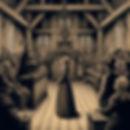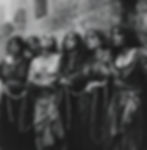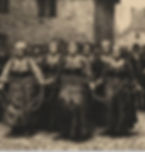The Paisley Witch Trials: A Dark Chapter in Scottish History
- Gavin Divers
- Mar 4
- 5 min read
Updated: Jul 4
Witchcraft trials were a widespread phenomenon across Europe and North America during the 16th and 17th centuries, resulting in the execution of thousands accused of sorcery. Scotland was no exception, with some of the most brutal and widespread witch hunts taking place under the Witchcraft Act of 1563. One of the most infamous of these occurred in Paisley in 1697, a tragic episode that saw the wrongful execution of seven individuals accused of practising witchcraft.

Today, the commemorative horseshoe, embedded in the cobblestones of Maxwellton Street, serves as a solemn reminder of the innocent lives lost. It stands as a symbol of remembrance, injustice, and the dangers of unchecked hysteria.
This article explores the events of the Paisley Witch Trials, the historical context, and modern efforts to preserve the memory of the victims.

The Context: Witchcraft in 17th-Century Scotland
The 17th century was a time of deep political, religious, and social upheaval. Scotland was a nation gripped by superstition, where misfortune—be it poor harvests, sudden illness, or unexplained deaths—was often blamed on witches. The Protestant Kirk (Church of Scotland) played a significant role in promoting the belief that witches consorted with the Devil, bringing ruin upon communities through their dark arts.
The Witchcraft Act of 1563 made witchcraft a capital offence, punishable by death by strangulation and burning. Between 1563 and 1736, an estimated 4,000 people in Scotland—predominantly women—were tried and executed for witchcraft, often on flimsy evidence such as spectral visions, curses, or simple disputes with neighbours.

By the late 17th century, belief in witches was slowly beginning to wane, but occasional outbreaks of hysteria still led to prosecutions. The Paisley Witch Trials of 1697 would prove to be one of the last major witch hunts in Scotland.
The Accusations: Christian Shaw and the Bargarran Household
The Paisley Witch Trials began with a seemingly insignificant incident in the household of John Shaw, Laird of Bargarran, near Paisley, Renfrewshire. His eleven-year-old daughter, Christian Shaw, accused a household servant, Katharine Campbell, of stealing a drink of milk. When confronted, Campbell allegedly muttered a curse under her breath.
Days later, Christian Shaw began suffering from violent fits, convulsions, and screaming episodes. She claimed to feel invisible hands pulling at her hair and choking her and reported seeing visions of witches and demons. Her condition worsened, and she exhibited symptoms eerily similar to those seen during the Salem Witch Trials in Massachusetts just five years earlier.

As the panic grew, Shaw’s family sought help from local ministers, physicians, and prominent townspeople. When no natural explanation could be found, the only conclusion drawn was that she had been bewitched. The accusations quickly expanded beyond Katharine Campbell, and soon, seven individuals from the community were accused of witchcraft.
The Accused: Who Were the Victims?
The seven accused were ordinary men and women, many of whom had little connection to Christian Shaw or her family. Their lives were torn apart by superstition and paranoia, leading them to an unjust and tragic fate.
Katharine Campbell – A young servant, originally from the Scottish Highlands, whose dispute with Christian Shaw set off the chain of accusations.
Janet Mathie – A widow, accused simply for being associated with another suspect.
John and James Lindsay – Brothers, aged just 11 and 14, highlighting how even children were not spared from accusations.
Margaret Jackson, Jean Fulton, and Margaret Fulton – Local women suspected of practising herbal medicine and folk healing, common targets of witchcraft trials.
Agnes Naismith – The last accused woman, who reportedly cursed her accusers before her execution, proclaiming that misfortune would plague their descendants.
These individuals were not witches—they were victims of a society consumed by fear.
The Trial: A Travesty of Justice
With hysteria at its peak, a special commission was set up by the Scottish Privy Council to oversee the trials. These types of commissions, similar to the English Commission of Oyer and Terminer (used in the Salem Witch Trials), were notorious for swift and severe judgments.
The accused were subjected to brutal interrogations and forced confessions. Witch trials in Scotland often relied on coercion, sleep deprivation, and the "witch pricking" technique, where a person’s skin was pierced with needles to find a "Devil’s Mark"—a spot that, if it did not bleed, was considered proof of guilt.

Despite no credible evidence, the seven accused were found guilty.
The Execution at Gallow Green
On 10th June 1697, the seven convicted individuals were taken to Gallow Green, a site near present-day Maxwellton Street. They were hanged and then burned at the stake, a gruesome method intended to destroy their bodies to prevent them from haunting the living.
Agnes Naismith, the final accused, is said to have cursed those responsible for their deaths, warning that their descendants would suffer for generations. Some believe her curse to be the reason for the misfortunes that later befell the Shaw family.
Christian Shaw’s Later Life and the Paisley Thread Industry
Despite the devastation she caused, Christian Shaw suffered no consequences. Instead, she rose to prominence as a successful industrialist.
After her husband died in 1721, she travelled to Holland to learn advanced spinning techniques, which she introduced to Scotland. She played a crucial role in establishing the Bargarran Thread Company, which contributed to Paisley’s rise as a textile hub.
Her life was marked by privilege and prosperity, a stark contrast to the fate of those she accused and helped condemn to death.
The Horseshoe Memorial and Modern Recognition
The Paisley Witch Trials were among the last large-scale executions for witchcraft in Western Europe. The Witchcraft Act was finally repealed in 1736, bringing an end to state-sanctioned persecution.
Today, the horseshoe on Maxwellton Street serves as a memorial to those wrongly executed. In 2008, a new bronze memorial was installed at Maxwellton Cross, designed by Scottish sculptor Sandy Stoddart. The inscription reads:
"Pain Inflicted, Suffering Endured, Injustice Done."
Additionally, Renfrewshire Witch Hunt 1697 (RWH 1697), a volunteer-led charity, works to preserve the memory of the victims and educate the public through historical research, walking tours, and community engagement.

Conclusion: Lessons from History
The Paisley Witch Trials remain a powerful warning about the dangers of mass hysteria, prejudice, and injustice. The accused were not witches, but victims of ignorance and fear.
As modern society continues to reckon with historical injustices, their story serves as a reminder of the need for justice, truth, and critical thinking.
Let us remember Janet Mathie, Katharine Campbell, John Lindsay, James Lindsay, Margaret Jackson, Jean Fulton, Margaret Fulton, and Agnes Naismith—not as witches, but as innocent people whose lives were cruelly taken.
Their story must continue to be told, so history never repeats itself.
Discover the chilling story behind the last mass witch hunt in Europe with Paisley Tours’ powerful Witches Walking Tour. This guided experience takes you through the very streets where innocent lives were forever changed in 1697. Led by passionate local historians, the tour uncovers the truth behind the trials, the superstitions that fuelled them and the legacy that still lingers today. Tours run every weekend — visit paisleytours.org.uk/tours to book or drop by the Discover Paisley hub at 2 County Place.
